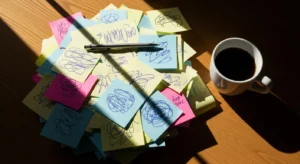
Does this sound familiar? You open your notebook or app, and there it is. The List. It’s long. It’s ambitious. It’s a monument to everything you should be doing. You stare at it, a wave of overwhelm washing over you. You pick an easy task, check it off for a tiny dopamine hit, and then spend the next hour scrolling, feeling vaguely guilty about the bigger, more important items that remain untouched.
If you nodded along, you are not alone. So many of us are trapped in a cycle of writing endless to-do lists, feeling a brief sense of control, and then ending the day feeling defeated. The list, which was supposed to be a tool for clarity, has become a source of anxiety. It’s a constant reminder of our perceived failures and a catalyst for distraction.
At TheFocusedMethod.com, we see this all the time. It’s not a personal failing; it’s a system failure. Your brain is not designed to operate like a computer, processing a long queue of commands. It’s a dynamic, energy-based system that needs the right conditions to thrive. Your productivity lists might be working against your brain’s natural rhythms, not with them.
This isn’t another article about finding the “perfect” task management app or a new way to format your list. This is about changing your relationship with your tasks. It’s about moving from a state of reactive overwhelm to one of proactive, intentional focus. We will explore the mental friction your to-do list creates and give you practical, evidence-aware focus rituals to reclaim your attention.
Together, we will transform your to-do list from a weapon of self-criticism into a compass that guides you toward what truly matters. We will learn how to use a to do list effectively, not just as a repository for tasks, but as a strategic tool for managing your most precious resource: your attention.
The goal is simple. Less guilt. More deep, satisfying work. Let’s begin.
📚 Table of Contents
- Understanding the “Why”: Your Brain, Energy, and the Tyranny of the List
- From List to Ritual: A New Framework for Daily Focus
- 1. The Startup Ritual (Your Morning Anchor)
- 2. The Deep-Work Entry Ritual (Crossing the Threshold)
- 3. Break Hygiene Ritual (The Art of the Productive Pause)
- 4. The Shutdown Ritual (Closing the Mental Tabs)
- Your 15-Minute Starter Pack
- Mind Over Matter: Essential Thought Tools for Focus
- 1. Reframe Perfectionism as “Professionalism”
- 2. Reduce Friction: Make Focus the Easiest Option
- 3. Script Your Reset: The Derailment Plan
- Putting It Into Practice: Two Common Scenarios
- Frequently Asked Questions About Focus and To-Do Lists
- Q1: Is it good to listen to music or white noise while working?
- Q2: I know multitasking is bad, but I feel like I have to do it. Is it really a myth?
- Q3: What should I do when my motivation completely disappears, even for my Most Important Task?
- Q4: My to-do list for my evenings and weekends is just as stressful as my work list. How can I manage that?
- Your Seven-Day Focus Challenge
Understanding the “Why”: Your Brain, Energy, and the Tyranny of the List
Before we can fix the problem, we need to understand it. Why does a simple to-do list, a cornerstone of classic productivity advice, so often lead to paralysis? The answer lies in the fundamental way our brains are wired to handle information and energy.
Think of your brain’s capacity for focused work not as a giant hard drive, but as a small, rechargeable battery. Every single decision you make, every piece of information you process, and every task you consider drains a little bit of that battery. This mental energy is what psychologists refer to as cognitive load. Cognitive load is the total amount of mental effort being used in your working memory. When you present your brain with a list of 27 unrelated tasks, you are dramatically increasing its cognitive load. It has to read, interpret, prioritize, and hold all those items in its active awareness. It’s exhausting before you’ve even started.
This is the first trap of the traditional to-do list. It’s not a plan; it’s a brain dump. It forces you into a state of decision fatigue. The mental energy you should be using to do the work is instead spent deciding what to do, when to do it, and how to do it. No wonder checking your email feels more appealing. It’s a simpler, pre-packaged decision.
The second trap is the illusion of productivity it creates. Writing the list feels like work. Organizing it feels like progress. But this “meta-work” often prevents us from engaging with the actual work. We get a small sense of accomplishment from curating the list, which can be just enough to satisfy the brain’s craving for closure, allowing us to procrastinate on the challenging tasks themselves. This is a classic form of productive procrastination.
Furthermore, our energy is not constant throughout the day. We all have natural energy rhythms, often called ultradian rhythms, which are 90-to-120-minute cycles of high-frequency brain activity followed by periods of lower-frequency activity. During the high-energy peaks, we are primed for deep focus and complex problem-solving. During the troughs, we need rest, recovery, and less demanding work. A giant, undifferentiated to-do list ignores this biological reality. It treats 9 AM and 3 PM as if they are identical in terms of your capacity, which they almost never are. Trying to force a high-energy task into a low-energy window is a recipe for frustration and failure. Effective task management is as much about managing your energy as it is about managing your tasks.
This leads us to the final problem: context switching. This is the mental cost of shifting your attention from one unrelated task to another. Imagine you’re writing an important report. Then you glance at your list and see “Call the dentist.” Your brain now has to disengage from the report, load the “dentist” context (their number, your schedule, the reason for the call), and then, after the call, try to reload the complex context of the report. Research from organizations like the American Psychological Association shows that even brief mental blocks created by shifting between tasks can cost as much as 40 percent of someone’s productive time. Your sprawling to-do list is an open invitation for constant context switching, shredding your focus into tiny, ineffective pieces.
So, the issue isn’t the list itself. It’s how we create and use it. We’ve been taught to use it as a dumping ground, when we should be using it as a surgical instrument. The solution is not to abandon lists, but to build a system around them—a system of rituals that respects your cognitive load, honors your energy rhythms, and minimizes the high cost of context switching.

From List to Ritual: A New Framework for Daily Focus
Instead of relying on a static, overwhelming list to guide your day, we’re going to build a dynamic system of rituals. These are small, repeatable sets of actions that create structure, conserve mental energy, and build momentum. They turn the abstract goals on your list into concrete, time-bound actions. This is where we implement to do list best practices in a way that serves your brain.
Think of these rituals as the guardrails for your attention. They protect your most valuable work from the chaos of a reactive day. Here are four core rituals you can start building today: the Startup, the Deep-Work Entry, Break Hygiene, and the Shutdown.
1. The Startup Ritual (Your Morning Anchor)
The goal of the Startup Ritual is to move from a vague sense of “I have so much to do” to a clear, confident plan for the next few hours. This is not about checking email or scrolling news. It’s a sacred 15-20 minutes to intentionally design your morning. You are the architect of your day, not a passive recipient of its demands.
First, take a moment to ground yourself. A few deep breaths can signal to your nervous system that it’s time to transition into a state of calm focus. Now, look at your master list (your brain dump of everything that needs doing). Do not work from this list directly. Instead, select just 1 to 3 “Most Important Tasks” (MITs) for the day. These are the tasks that, if completed, would make you feel accomplished and move you closer to your goals. Be realistic. The point is to win the day, not to list every possibility.
Next, you will “time-block” these tasks. Open your calendar and assign a specific, protected block of time to each MIT. For example: “9:00 AM – 10:30 AM: Draft Project Proposal.” This act of scheduling transforms a floating “to-do” into a concrete appointment with yourself. It dramatically reduces the cognitive load of deciding what to do next throughout the day. You’ve already made that decision when your mind was fresh.
Finally, identify any smaller, necessary-but-shallow tasks (like responding to a specific email or making a quick call). Group these into a separate, designated block, perhaps for 30 minutes in the late morning or afternoon. This prevents them from splintering your deep work sessions.
2. The Deep-Work Entry Ritual (Crossing the Threshold)
You’ve scheduled your first deep work block. But starting a complex task can be daunting. The Deep-Work Entry Ritual is a 2-minute “launch sequence” that helps you overcome that initial resistance and transition smoothly into a state of concentration.
Before you begin, prepare your environment. Close all unnecessary browser tabs. Put your phone in another room or turn it on “Do Not Disturb.” Clear your physical desk of any clutter. This simple act of “clearing the decks” signals to your brain that it’s time for serious work.
Next, state your intention clearly. You can say it out loud or write it on a sticky note: “For the next 90 minutes, I am going to focus solely on outlining the marketing plan.” This specificity is crucial. It gives your mind a clear target.
Finally, start with a “first, tiny step.” If you’re writing a report, your first step isn’t “write the report.” It’s “open the document and write one sentence.” If you’re coding, it’s “write the first function.” This ridiculously small first action bypasses the part of your brain that fears big, ambiguous tasks. Once you’ve taken that tiny step, momentum begins to build.
This process is about creating the conditions for monotasking, or single-tasking. Monotasking is the practice of dedicating your full cognitive resources to one single task for a sustained period. It is the opposite of context switching and the direct path to achieving a flow state—that magical, immersive state where you are so absorbed in an activity that time seems to fly by and your performance soars. Flow is not accidental; it is a consequence of deep, uninterrupted monotasking.
3. Break Hygiene Ritual (The Art of the Productive Pause)
Your brain is not a machine. As we discussed, it operates in cycles. Pushing through a natural low-energy trough is counterproductive; it leads to burnout and diminishing returns. Effective breaks are not a sign of weakness; they are a strategic necessity for sustained high performance. This is where Break Hygiene comes in.
When your deep work timer goes off (after 60-90 minutes, for example), you must honor the break. A “bad” break involves activities that are cognitively demanding or lead to distraction loops, like scrolling social media or checking news headlines. These activities don’t allow your prefrontal cortex—the part of your brain responsible for focus and decision-making—to rest. You come back to your work feeling more scattered, not less.
Good Break Hygiene involves activities that are restorative. Stand up, stretch, and walk around. Get a glass of water. Look out a window and let your eyes focus on something in the distance. Do a few simple breathing exercises. Let your mind wander. The key is to engage in something low-stimulus and preferably physical. A 5-10 minute break with good hygiene can reset your cognitive battery, allowing you to return to your next block of work with renewed clarity and energy.
4. The Shutdown Ritual (Closing the Mental Tabs)
One of the main reasons we feel overwhelmed and struggle to relax in the evenings is that our work is never “done.” The open loops from our to-do list follow us home, creating a low-grade hum of anxiety. The Shutdown Ritual is a clear, definitive end to your workday.
In the last 15 minutes of your scheduled day, stop working. Take a quick look at your calendar and master list. Tidy up any loose ends if possible, but more importantly, make a quick plan for tomorrow. Identify your top 1-2 priorities for the next day. This “pre-planning” offloads the mental burden from your evening brain, which is tired and ill-equipped for complex planning. You are essentially giving your future self a gift: a clear starting point.
Next, tidy your physical workspace. A clean desk in the evening leads to a clear mind in the morning. Finally, and this is the most important part, say a specific phrase out loud to signify the end of work. It could be as simple as, “Shutdown complete.” This verbal cue creates a powerful psychological boundary between your work life and your personal life. It closes the mental tabs, allowing your brain to fully disengage and recharge, which is vital for your well-being and for your performance the next day.
Your 15-Minute Starter Pack
Feeling overwhelmed by these rituals? Start small. For the next week, commit to just this 15-minute routine:
Morning (5 mins): Before checking your phone, write down your single Most Important Task for the day on a sticky note. Just one.
End of Day (10 mins): Review your day. Decide on your Most Important Task for tomorrow. Tidy your desk. Say “Shutdown complete.”
This tiny investment is how to use a to do list effectively at the most basic level. It establishes a rhythm and begins to build the foundation for deeper, more sustained focus.

Mind Over Matter: Essential Thought Tools for Focus
Building a system of rituals is a powerful step, but true, lasting focus also requires an internal shift. We need to upgrade our mental software. How we think about our work, our lists, and our inevitable distractions profoundly impacts our ability to perform. Here are three “thought tools” to help you reframe your mindset for less friction and more flow.
1. Reframe Perfectionism as “Professionalism”
Perfectionism is one of the biggest enemies of focus. It’s the voice that whispers, “Don’t start until the conditions are perfect,” or “This isn’t good enough, you need to rethink the whole thing.” It transforms a straightforward task on your to-do list into a monumental test of your self-worth. This immense pressure makes starting incredibly difficult, leading to procrastination.
The reframe is to shift your goal from “perfect” to “professional.” A professional doesn’t wait for inspiration to strike. A professional shows up on time, does the work consistently, and delivers a high-quality result within the given constraints. A professional understands that “done” is better than “perfect.”
When you feel the pull of perfectionism, ask yourself: “What would a professional do right now?” A professional writer would write a messy first draft, knowing it can be edited later. A professional developer would ship the functional code, not wait for the most elegant solution in the world. A professional consultant delivers the report by the deadline, even if they wish they had one more week to polish it.
This mindset doesn’t mean you produce sloppy work. It means you respect the process. It means you focus on shipping, learning, and iterating. Adopting a “professional” mindset lowers the stakes of any single task, making it easier to engage with your deep work blocks and check items off your list with a sense of accomplishment rather than anxiety.
2. Reduce Friction: Make Focus the Easiest Option
Our brains are wired to follow the path of least resistance. If checking social media is easy (your phone is on your desk, notifications are on) and starting your report is hard (you have to find the file, remember where you left off, and block out distractions), your brain will choose social media every time. The secret is to reverse this. Make focus easy and distraction hard.
This is a design problem, not a willpower problem. Instead of trying to force yourself to focus, architect your environment to pull you toward it. This is a core principle of effective task management. Each small bit of friction you add to a distraction, and each bit you remove from your desired task, makes a huge difference over time.
To add friction to distractions:
– Log out of social media accounts at the end of each session.
– Use website blockers during your deep work blocks.
– Put your phone in a different room or in a drawer.
– Turn off all non-essential notifications on your computer and phone.
To remove friction from focused work:
– During your Shutdown Ritual, leave the tab for tomorrow’s first task open on your computer.
– If you’re writing, leave a note for yourself like, “Tomorrow, start by expanding on this point…”
– Prepare everything you need for the task ahead of time. If you’re going to the gym, lay out your clothes the night before. If you’re painting, set up your canvas and paints.
By consciously managing friction, you stop fighting a constant battle of willpower. You make your intended actions the most logical, easy, and natural choice for your brain to make.
3. Script Your Reset: The Derailment Plan
No system is perfect. You will get distracted. A fire-drill email will land in your inbox. A child will get sick. You’ll fall down a research rabbit hole. The worst part isn’t the distraction itself; it’s the shame and frustration that follows. We often think, “Well, I’ve already ruined my focus for the day, might as well give up.”
This is where a scripted reset comes in. You need a simple, pre-decided plan for what to do the moment you realize you’ve been derailed. Having a plan removes the need for in-the-moment, emotionally-charged decision-making.
Your script can be very simple. For example:
“Okay, I got distracted. It happens. I will now stand up, take three deep breaths, get a glass of water, and look at the sticky note with my single Most Important Task. Then I will set a timer for just 25 minutes and work only on that.”
The key elements are:
Acknowledge without judgment: “I got distracted. It happens.” This self-compassion is vital.
A physical pattern interrupt: Standing up and getting water breaks the mental loop of the distraction.
Re-anchor to your intention: Looking at your MIT reminds you of your original plan.
A small, non-intimidating next step: A 25-minute timer (the Pomodoro technique) feels much more manageable than jumping back into a 90-minute block.
Write your script down and keep it visible. The next time you find yourself 20 minutes deep into an unplanned YouTube session, you won’t have to think. You just execute the script. This thought tool transforms a moment of failure into an opportunity to practice resilience and get back on track quickly.

Putting It Into Practice: Two Common Scenarios
Theory is one thing, but application is everything. Let’s walk through how to apply these rituals and thought tools in two common, challenging situations. This is how we move from a generic understanding of productivity lists to a specific, actionable strategy.
Scenario 1: The Tight Deadline
The Situation: It’s Tuesday afternoon, and you have a major project report due by noon on Wednesday. You feel a rising sense of panic. Your to-do list is a chaotic jumble of other tasks that are also screaming for your attention. The temptation is to multitask furiously, trying to do everything at once.
The Old Way: You keep the long to-do list open, constantly glancing at it, which triggers anxiety. You try to write the report while simultaneously answering “urgent” emails that pop up. Your focus is shattered. You work late into the night, fueled by caffeine and stress, and produce a subpar report.
The Focused Method Way:
1. Execute a Mini-Shutdown & Startup: Stop everything. Take five deep breaths. Acknowledge the panic. Now, perform a rapid version of the Shutdown and Startup rituals. Declare everything else “off-limits” until the report is done. Your single Most Important Task is “Finish Report Draft.” All other to-dos are irrelevant for now.
2. Time-Block Aggressively: Open your calendar. Block out two or three 90-minute “Report Focus Blocks” between now and the deadline, with 15-minute restorative breaks in between. For example: 3:00-4:30 PM, 5:00-6:30 PM, and 9:00-10:30 AM tomorrow. This creates a clear, visible pathway to completion.
3. Reduce Friction: Create a “deadline bubble.” Close your email client and all unnecessary tabs. Put an auto-responder on your email if necessary. Turn your phone completely off and place it in another room. The only thing on your screen should be the report document.
4. Use the Deep-Work Entry Ritual: Before each 90-minute block, state your specific goal. “In this block, I will write the ‘Financials’ section.” Then, identify the tiniest first step: “My first step is to open the spreadsheet with the Q3 numbers.” This makes starting feel effortless.
5. Practice Break Hygiene: During your 15-minute breaks, do not check your email or phone. That will pull you out of the report context and inject new stress. Instead, walk around, drink water, stretch. Let your brain consolidate the information you’ve just been working on. This is a crucial part of how to use a to do list effectively under pressure—by protecting your recovery time.
By following this structured approach, you channel your nervous energy into a calm, focused, and effective plan. You complete the report with less stress and to a higher standard.
Scenario 2: The Noisy, Distracting Home Environment
The Situation: You work from home. Your kids are on school holidays, the dog is barking, and your partner is on loud conference calls. Your environment is a minefield of interruptions. It feels impossible to get any deep work done.
The Old Way: You try to “power through the noise.” You get frustrated and irritable with every interruption. You repeatedly re-read the same paragraph, making little progress. You end the day exhausted and feeling like you accomplished nothing, which strains your relationships.
The Focused Method Way:
1. Redefine the “Workday”: Acknowledge that a traditional 9-to-5 structure is impossible. Your focus needs to be on “pockets of productivity.” Your goal isn’t eight hours of work; it’s two or three highly focused 60-minute blocks.
2. Communicate Your Blocks: During your Startup Ritual, identify the best times for your focus blocks. Maybe it’s early in the morning before everyone is up, or during a specific nap time. Communicate these blocks to your family. “From 10:00 to 11:00 AM, I’m going into my office for a focus session. Please only interrupt me if it’s a real emergency.” Using headphones can be a powerful visual cue for “do not disturb.”
3. Master the Scripted Reset: You will be interrupted. It’s inevitable. The key is how you handle it. When an interruption occurs, attend to it calmly. Afterwards, don’t just sit back down and try to work. Execute your reset script. Stand up, take a breath, glance at your MIT, and set a timer for just 20 minutes to ease back in. This prevents one interruption from derailing your entire day.
4. Adapt Your Tasks: Use your high-focus, protected blocks for your most demanding work (writing, strategic thinking). Use the more chaotic, unpredictable times for shallow work that can withstand interruptions (organizing files, answering simple emails, brainstorming on a notepad). This is energy-appropriate task management.
5. Use a Shutdown Ritual to Reconnect: At the end of your workday, perform your Shutdown Ritual with intention. Close the laptop. Tidy the desk. Say “Shutdown complete.” This creates a clear boundary that allows you to be fully present with your family, reducing the guilt and stress that comes from feeling like you should always be working.
In this scenario, the focus is on control and adaptation. You can’t control the environment, but you can control your system, your communication, and your response to distractions.

Frequently Asked Questions About Focus and To-Do Lists
As a focus coach, I hear many of the same questions from clients who are struggling to manage their attention. Here are answers to some of the most common ones, incorporating the principles we’ve discussed.
Q1: Is it good to listen to music or white noise while working?
A: This is highly individual, but there are some general guidelines. For many people, music can be a powerful tool for focus, but the type of music matters. Music with lyrics can often engage the language-processing parts of your brain, which can interfere with tasks that also require language, like writing or reading. For this reason, many people find instrumental music—such as classical, electronic, or film scores—to be more effective.
White noise, brown noise, or nature sounds (like rain) work by masking distracting ambient sounds and creating a consistent, predictable auditory environment. This can be incredibly helpful in a noisy office or home. The key is to find something that helps you focus without becoming a distraction itself. Experiment and see what works for you. The goal is to create a sound cocoon that signals to your brain that it’s time for a deep work session.
Q2: I know multitasking is bad, but I feel like I have to do it. Is it really a myth?
A: The idea that humans can effectively multitask on complex tasks is largely a myth. What we call multitasking is actually rapid “task-switching” or “context switching.” As we discussed earlier, every time you switch, you pay a cognitive penalty. Your brain has to disengage from one task and load the context for the new one. This process is inefficient, leads to more errors, and increases stress and mental fatigue. For more on the science behind attention and performance, resources from institutions like the National Institutes of Health can be very informative.
Instead of trying to do two things at once, practice “batching.” Group similar, shallow tasks together. For example, have a designated “email block” where you answer all your emails at once, rather than checking them sporadically. Have a “calls block” for making all your phone calls. This is a much more effective way to handle multiple demands than trying to juggle them simultaneously. This is a core tenant of to do list best practices: group like with like.
Q3: What should I do when my motivation completely disappears, even for my Most Important Task?
A: Motivation is a fickle emotion; discipline is a reliable system. On days when you feel zero motivation, do not rely on it. Rely on your rituals. Specifically, lean on the Deep-Work Entry Ritual and the principle of reducing friction. The goal is not to “get motivated”; the goal is to start.
Make the first step so laughably small that you can’t say no. Your goal isn’t “Write the report.” Your goal is “Open the document.” Your goal isn’t “Analyze the data.” It’s “Open the spreadsheet.” Then, set a timer for just 10 or 15 minutes. Anyone can do something for 10 minutes. More often than not, action creates its own motivation. Once you get started, the momentum will build, and you may find yourself entering a state of flow. If after 15 minutes you still feel completely drained, it might be a sign that you need a strategic break, not more willpower. Listen to your body’s energy signals.
Q4: My to-do list for my evenings and weekends is just as stressful as my work list. How can I manage that?
A: This is an excellent question because the principles of focus and energy management apply to all areas of life. The same cognitive load and decision fatigue can happen with personal tasks. The solution is to apply the same system, but with a different goal. The goal of your personal time isn’t productivity; it’s restoration, connection, and enjoyment.
Instead of a long, nagging to-do list of chores, try creating a “to-be” list or a “could-do” list. On Friday afternoon, as part of your work Shutdown Ritual, you can also perform a “Personal Startup Ritual” for the weekend. Ask yourself: “How do I want to feel this weekend? Rested? Connected? Creative?” Then, identify just one or two key activities that will help you feel that way. Maybe it’s a long walk without your phone, dedicated playtime with your kids, or an hour to read a novel. Schedule these restorative activities just as you would a work task. For chores, batch them into a single “life admin” block on Saturday morning so they don’t loom over your entire weekend.

Your Seven-Day Focus Challenge
We’ve covered a lot of ground, from the neuroscience of attention to the practical rituals that build focus. But knowledge without action is just trivia. The real transformation happens when you start to apply these ideas, even in a small way. Your relationship with your to-do list won’t change overnight, but you can lay a new foundation in just one week.
Your task is not to implement everything perfectly. Your task is to experiment, to be curious, and to be kind to yourself. The goal is to prove to yourself that a different way of working—and feeling—is possible. Here are three simple actions to commit to for the next seven days. Think of this as your focus-building starter kit.
1. Define One MIT Each Morning. Before you check your email or look at your phone, take just two minutes. Look at your master list and choose your single Most Important Task (MIT) for the day. Write it on a physical sticky note and place it on your computer monitor. This single act will serve as your compass. When you feel lost or distracted, your eye will catch the note, reminding you of your true priority.
2. Practice a True Shutdown. For the next seven workdays, commit to a hard stop. Fifteen minutes before your planned end time, stop working. Clear your desk. Quickly identify your MIT for tomorrow. Then, say the words “Shutdown complete” out loud. This will feel strange at first, but it is a powerful way to create the psychological boundary your brain needs to truly rest and recharge.
3. Take One Restorative Break. Just once per day, when you take a break, do it with intention. Instead of picking up your phone, stand up and walk away from your desk for five minutes. Get a glass of water, look out a window, or do some simple stretches. Pay attention to how you feel when you return to your work. This is the beginning of learning to manage your energy, not just your time.
That’s it. One priority, one boundary, and one real break each day. This is how you begin to move from being a “to-do list addict” to becoming an architect of your own attention. You are not just managing tasks; you are cultivating a more focused, fulfilling, and sustainable way of working and living. We at TheFocusedMethod.com are here to support you on that journey. You have the capacity for deep, meaningful focus. Let’s unlock it together.
Disclaimer
The information provided in this article is for educational and informational purposes only and is not intended as a substitute for professional medical or psychological advice, diagnosis, or treatment. Always seek the advice of your physician or other qualified health provider with any questions you may have regarding a medical or mental health condition.






